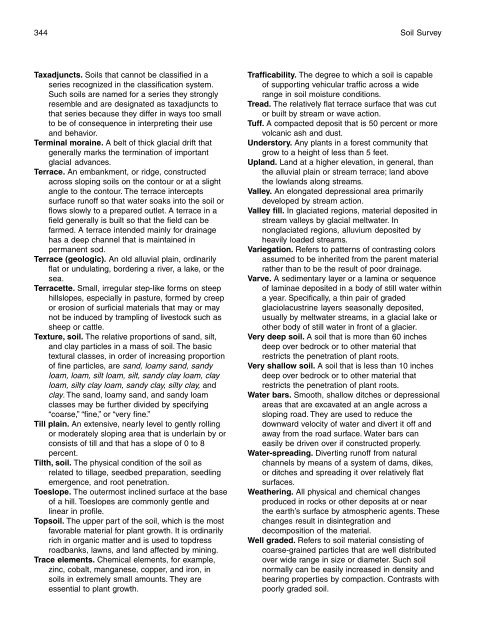Soil Survey of Sweet Grass County Area, Montana - Soil Data Mart
Soil Survey of Sweet Grass County Area, Montana - Soil Data Mart
Soil Survey of Sweet Grass County Area, Montana - Soil Data Mart
You also want an ePaper? Increase the reach of your titles
YUMPU automatically turns print PDFs into web optimized ePapers that Google loves.
344 <strong>Soil</strong> <strong>Survey</strong><br />
Taxadjuncts. <strong>Soil</strong>s that cannot be classified in a<br />
series recognized in the classification system.<br />
Such soils are named for a series they strongly<br />
resemble and are designated as taxadjuncts to<br />
that series because they differ in ways too small<br />
to be <strong>of</strong> consequence in interpreting their use<br />
and behavior.<br />
Terminal moraine. A belt <strong>of</strong> thick glacial drift that<br />
generally marks the termination <strong>of</strong> important<br />
glacial advances.<br />
Terrace. An embankment, or ridge, constructed<br />
across sloping soils on the contour or at a slight<br />
angle to the contour. The terrace intercepts<br />
surface run<strong>of</strong>f so that water soaks into the soil or<br />
flows slowly to a prepared outlet. A terrace in a<br />
field generally is built so that the field can be<br />
farmed. A terrace intended mainly for drainage<br />
has a deep channel that is maintained in<br />
permanent sod.<br />
Terrace (geologic). An old alluvial plain, ordinarily<br />
flat or undulating, bordering a river, a lake, or the<br />
sea.<br />
Terracette. Small, irregular step-like forms on steep<br />
hillslopes, especially in pasture, formed by creep<br />
or erosion <strong>of</strong> surficial materials that may or may<br />
not be induced by trampling <strong>of</strong> livestock such as<br />
sheep or cattle.<br />
Texture, soil. The relative proportions <strong>of</strong> sand, silt,<br />
and clay particles in a mass <strong>of</strong> soil. The basic<br />
textural classes, in order <strong>of</strong> increasing proportion<br />
<strong>of</strong> fine particles, are sand, loamy sand, sandy<br />
loam, loam, silt loam, silt, sandy clay loam, clay<br />
loam, silty clay loam, sandy clay, silty clay, and<br />
clay. The sand, loamy sand, and sandy loam<br />
classes may be further divided by specifying<br />
“coarse,” “fine,” or “very fine.”<br />
Till plain. An extensive, nearly level to gently rolling<br />
or moderately sloping area that is underlain by or<br />
consists <strong>of</strong> till and that has a slope <strong>of</strong> 0 to 8<br />
percent.<br />
Tilth, soil. The physical condition <strong>of</strong> the soil as<br />
related to tillage, seedbed preparation, seedling<br />
emergence, and root penetration.<br />
Toeslope. The outermost inclined surface at the base<br />
<strong>of</strong> a hill. Toeslopes are commonly gentle and<br />
linear in pr<strong>of</strong>ile.<br />
Topsoil. The upper part <strong>of</strong> the soil, which is the most<br />
favorable material for plant growth. It is ordinarily<br />
rich in organic matter and is used to topdress<br />
roadbanks, lawns, and land affected by mining.<br />
Trace elements. Chemical elements, for example,<br />
zinc, cobalt, manganese, copper, and iron, in<br />
soils in extremely small amounts. They are<br />
essential to plant growth.<br />
Trafficability. The degree to which a soil is capable<br />
<strong>of</strong> supporting vehicular traffic across a wide<br />
range in soil moisture conditions.<br />
Tread. The relatively flat terrace surface that was cut<br />
or built by stream or wave action.<br />
Tuff. A compacted deposit that is 50 percent or more<br />
volcanic ash and dust.<br />
Understory. Any plants in a forest community that<br />
grow to a height <strong>of</strong> less than 5 feet.<br />
Upland. Land at a higher elevation, in general, than<br />
the alluvial plain or stream terrace; land above<br />
the lowlands along streams.<br />
Valley. An elongated depressional area primarily<br />
developed by stream action.<br />
Valley fill. In glaciated regions, material deposited in<br />
stream valleys by glacial meltwater. In<br />
nonglaciated regions, alluvium deposited by<br />
heavily loaded streams.<br />
Variegation. Refers to patterns <strong>of</strong> contrasting colors<br />
assumed to be inherited from the parent material<br />
rather than to be the result <strong>of</strong> poor drainage.<br />
Varve. A sedimentary layer or a lamina or sequence<br />
<strong>of</strong> laminae deposited in a body <strong>of</strong> still water within<br />
a year. Specifically, a thin pair <strong>of</strong> graded<br />
glaciolacustrine layers seasonally deposited,<br />
usually by meltwater streams, in a glacial lake or<br />
other body <strong>of</strong> still water in front <strong>of</strong> a glacier.<br />
Very deep soil. A soil that is more than 60 inches<br />
deep over bedrock or to other material that<br />
restricts the penetration <strong>of</strong> plant roots.<br />
Very shallow soil. A soil that is less than 10 inches<br />
deep over bedrock or to other material that<br />
restricts the penetration <strong>of</strong> plant roots.<br />
Water bars. Smooth, shallow ditches or depressional<br />
areas that are excavated at an angle across a<br />
sloping road. They are used to reduce the<br />
downward velocity <strong>of</strong> water and divert it <strong>of</strong>f and<br />
away from the road surface. Water bars can<br />
easily be driven over if constructed properly.<br />
Water-spreading. Diverting run<strong>of</strong>f from natural<br />
channels by means <strong>of</strong> a system <strong>of</strong> dams, dikes,<br />
or ditches and spreading it over relatively flat<br />
surfaces.<br />
Weathering. All physical and chemical changes<br />
produced in rocks or other deposits at or near<br />
the earth’s surface by atmospheric agents. These<br />
changes result in disintegration and<br />
decomposition <strong>of</strong> the material.<br />
Well graded. Refers to soil material consisting <strong>of</strong><br />
coarse-grained particles that are well distributed<br />
over wide range in size or diameter. Such soil<br />
normally can be easily increased in density and<br />
bearing properties by compaction. Contrasts with<br />
poorly graded soil.
















